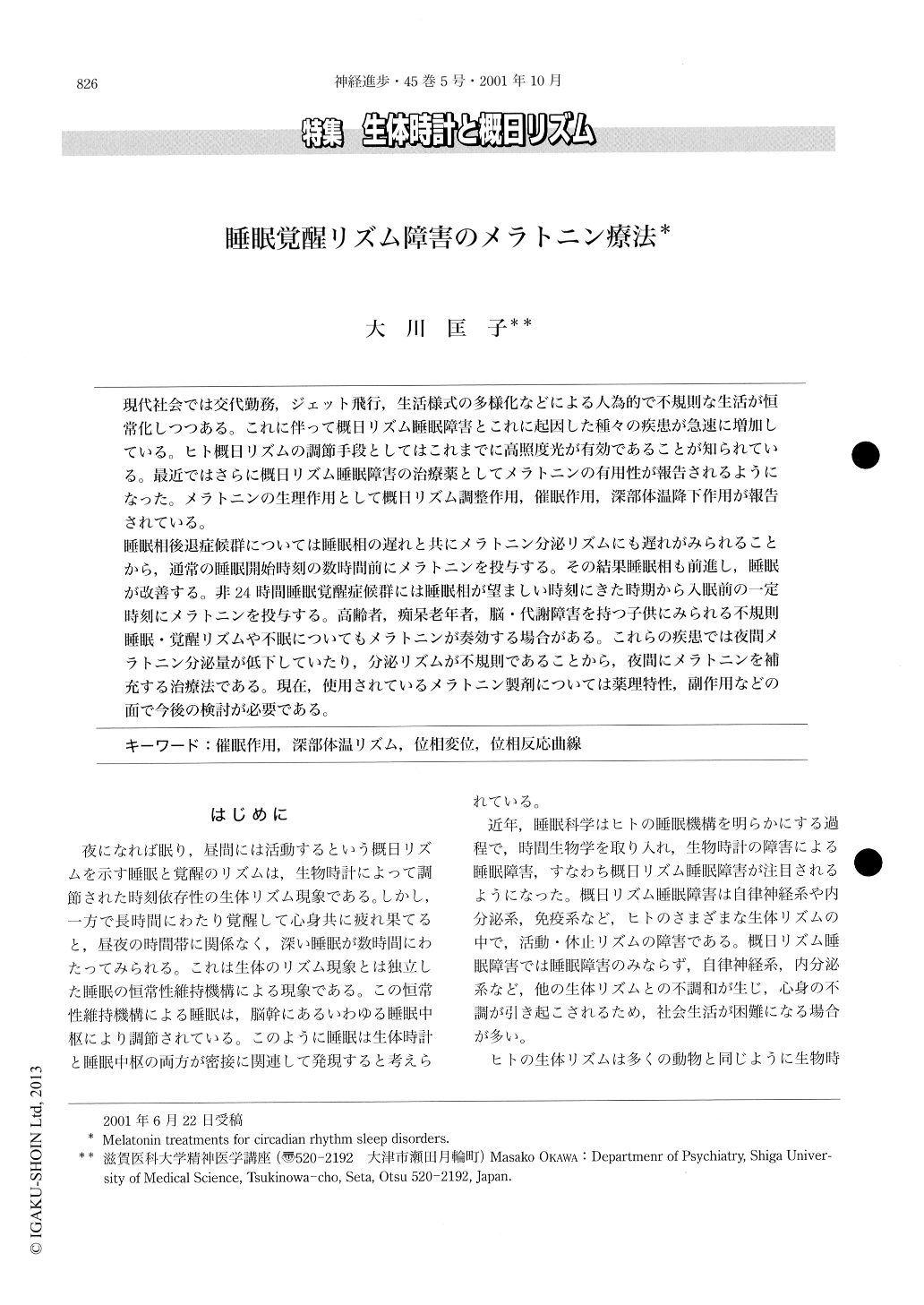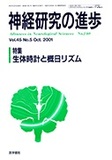Japanese
English
- 有料閲覧
- Abstract 文献概要
- 1ページ目 Look Inside
現代社会では交代勤務,ジェット飛行,生活様式の多様化などによる人為的で不規則な生活が恒常化しつっある。これに伴って概日リズム睡眠障害とこれに起因した種々の疾患が急速に増加している。ヒト概日リズムの調節手段としてはこれまでに高照度光が有効であることが知られている。最近ではさらに概日リズム睡眠障害の治療薬としてメラトニンの有用性が報告されるようになった。メラトニンの生理作川として概日リズム調整作川,催眠作用,深部体温降下作川が報告されている。
睡眠相後退症候群については睡眠相の遅れと共にメラトニン分泌リズムにも遅れがみられることから,通常の睡眠開始時刻の数時間前にメラトニンを投与する。その結果睡眠相も前進し,睡眠が改善する。非24時間睡眠覚醒症候群には睡眠相が望ましい時刻にきた時期から人眠前の一定時刻にメラトニンを投与する。高齢者,痴呆老年者,脳・代謝障害を持つ子供にみられる不規則睡眠・覚醒リズムや不眠についてもメラトニンが奏効する場合がある。これらの疾患では夜間メラトニン分泌量が低下していたり,分泌リズムが不規則であることから,夜間にメラトニンを補充する治療法である。現在,使用されているメラトニン製剤については薬理特性,副作用などの面で今後の検討が必要である。
This papper is intended to provide an overview of a physiological role of melatonin (MLT) in sleep-wake regu-lation of MLT for circadian rhythm sleep disorders. The pineal hormone MLT has a distinct daily rhythm of secre-tion that is linked with sleep. MLT concentration in blood is high during the nighttime and nealy undetectable dur-ing the daytime. In human MLT studies, MLT has significantly increased sleepiness and fatigue during the day-time but not at night, which indicates time-dependent sleep-promoting effect of MLT. On the other hand, MLT is known to have phase-shifting effect of biological clock. Phase response curve (PRC) for MLT administration was introduced in human studies. Successful melatonin treatments for circadian rhythm sleep-disorders based on PRC have been reported. MLT is known to decrease core body temperature. Effects of MLT on sleep-wake cycle may be mediated by a combination of sleep-promoting and phase-shifting actions and may involve the tempera-ture lowering effect.
In the international classification of sleep disorders (1990), circadian rhythm sleep disorders are divided into the following three major subtypes.
1) Non-24 hour sleep-wake syndrome characterized by a chronic steady pattern with 1-2 hour daily delays in sleep and wake times. In these patients sleep onset and offset times occur at a period about every 25 hours in spite of living in the normal 24-hour society.
2) Delayed sleep phase syndrome (DSPS). The major sleep episode is delayed in relation to the desired clock time. The patients suffer from a severe difficulty in falling sleep at night. They are unable to advance the sleep phase to earlier hours by enforcing a conventional sleep phase.
3) Irregular sleep-wake cycle. This pattern consists of temporarily disorganized and variable sleep and waking behavior. No regular pattern of the sleep-wake cycle is observed for a long period.
In DSPS, melatonin rhythms delay in accordance with sleep-wake rhythm. For treatment of DSPS, exogenous melatonin administration at a dose of 0.3~1 mg, 1~3 times during 3~4 hours before desired bedtime success-fully advanced sleep onset and sleep-wake rhythm as well as body temperature rhythm.
For non-24 hour sleep-wake rhythm, 1~3 mg of melatonin administration before bedtime when the sleep phase shifted to desirable night time seem to be effective.
Aging is often associated with sleep-waking disorders especially in elderly people with dementia. In these eld-erly, reduction in melatonin secretion with aging may be a causal or exacerbating factor in sleep disturbances ob-served in the age group. Supplementary administration of exogenous melatonin has been reported to be effective for treatment of sleep-wake rhythm disorders and insomnia. Brain impaired children, with or without blindness, Angelman syndrome often develops various sleep disorders ; DSPS non-24 sleep wake syndrome, irregular sleep-wake rhythm.
These sleep disorders seem to be related to insufficient melatonin secretion at night. Melatonin administration in early night improved night sleep in these children.
Finally, despite major advances in our understanding of the role of melatonin as the hormon of darkness' thera-peutic implications of this understanding continue to lag. We have to be cautious pharmacokinetics and side ef-fects of melatonin future use for circadian rhythm sleep disorders.

Copyright © 2001, Igaku-Shoin Ltd. All rights reserved.


